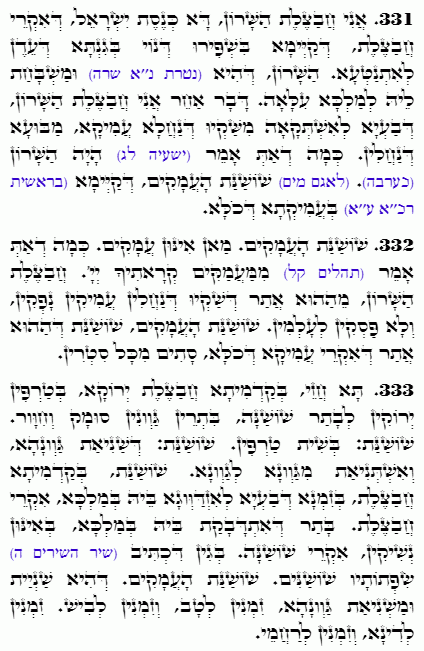Daily Zohar # 4599 – Emor – Help Lily become a rose
Daily Zohar 4599

Hebrew translation:
332. שׁוֹשַׁנַּת הָעֲמָקִים, מִי הֵם הָעֲמָקִים? כְּמוֹ שֶׁנֶּאֱמַר (תהלים קל) מִמַּעֲמַקִּים קְרָאתִיךָ ה’. חֲבַצֶּלֶת הַשָּׁרוֹן, מֵאוֹתוֹ מָקוֹם שֶׁהַשְׁקָאַת הַנְּחָלִים הָעֲמֻקִּים יוֹצְאִים וְלֹא פוֹסְקִים לְעוֹלָמִים. שׁוֹשַׁנַּת הָעֲמָקִים, הַשּׁוֹשַׁנָּה שֶׁל אוֹתוֹ מָקוֹם שֶׁנִּקְרָא עֹמֶק הַכֹּל, נִסְתָּר מִכָּל הַצְּדָדִים.
333. בֹּא רְאֵה, בָּרִאשׁוֹנָה חֲבַצֶּלֶת יְרֻקָּה עִם עָלִים יְרֻקִּים, אַחַר כָּךְ שׁוֹשַׁנָּה בִּשְׁנֵי גְוָנִים – אָדֹם וְלָבָן. שׁוֹשַׁנַּת – בְּשִׁשָּׁה עָלִים. שׁוֹשַׁנַּת – שֶׁשִּׁנְּתָה אֶת גְּוָנֶיהָ, וּמִשְׁתַּנָּה מִגָּוֶן לְגָוֶן. שׁוֹשַׁנַּת, בָּרִאשׁוֹנָה חֲבַצֶּלֶת. בִּזְמַן שֶׁרוֹצָה לְהִזְדַּוֵּג עִם הַמֶּלֶךְ, נִקְרֵאת חֲבַצֶּלֶת. אַחַר שֶׁנִּדְבְּקָה עִם הַמֶּלֶךְ עִם אוֹתָן נְשִׁיקוֹת, נִקְרֵאת שׁוֹשַׁנָּה, מִשּׁוּם שֶׁכָּתוּב (שיר ה) שִׂפְתוֹתָיו שׁוֹשַׁנִּים. שׁוֹשַׁנַּת הָעֲמָקִים. שֶׁהִיא מִשְׁתַּנָּה וּמְשַׁנָּה אֶת גְּוָנֶיהָ, לִפְעָמִים לְטוֹב, וְלִפְעָמִים לְרָע. לִפְעָמִים לְדִין, וְלִפְעָמִים לְרַחֲמִים.
.
Zohar Emor
Continued from previous DZ
#331
“אֲנִי חֲבַצֶּלֶת הַשָּׁרוֹן” “I am the rose of Sharon”: This refers to the Congregation of Israel, which is Malchut, known as the “rose,” standing in the splendor of beauty in the Garden of Eden, to be planted there. “שרון” “Sharon,” which means “to sing” or “to praise,” signifies that she praises the Supreme King, who is Zeir Anpin.
Another interpretation: “I am the rose of Sharon,” which is Malchut, requires watering from the deep stream, the fountain of the rivers, which is Binah, as it is written, “הָיָה הַשָּׁרוֹן כָּעֲרָבָה” “The Sharon shall be like a wilderness” (Isaiah 33:9), meaning that Sharon symbolizes a flat land or plain. In other words, the rose in the plain is thirsty for water.
#332
“שׁוֹשַׁנַּת הָעֲמָקִים” “Lily of the valleys”: This means she stands in the deepest place of all. “Lily of the valleys,” what are the valleys? It is as it is written,” שִׁיר הַמַּעֲלוֹת מִמַּעֲמַקִּים קְרָאתִיךָ יְהוָה” “Out of the depths I have called to You, O YHVH” (Psalms 130:1). The rose of Sharon is from that place where the watering of deep streams originates and never ceases, meaning from the place of revelation of Binah. “Lily of the valleys” refers to the lily from that place called the deepest of all, hidden from all sides, meaning from the concealed place of Binah.
#333
“Come and see: In the beginning, Malchut is like a ‘lily of the valleys,’ green with green leaves. Afterward, she becomes a rose with two colors, red and white. A rose has six petals. A rose changes its colors, transforming from one color to another. At first, she is called “חֲבַצֶּלֶת” a ‘lily,’ that is, when she desires to unite with the King. After she cleaves to the King with these kisses, she is called “שׁוֹשַׁנָּה” a ‘rose,’ as it is written,
Songs 5:13
“לְחָיָו כַּעֲרוּגַת הַבֹּשֶׂם מִגְדְּלוֹת מֶרְקָחִים שִׂפְתוֹתָיו שׁוֹשַׁנִּים נֹטְפוֹת מוֹר עֹבֵר.”
“His cheeks are like a bed of spices, Banks of scented herbs. His lips are lilies, Dripping liquid myrrh.”
‘שׁוֹשַׁנַּת הָעֲמָקִים’ ‘Lily of the valleys’ means she changes and transforms her colors, sometimes for good, sometimes for bad, sometimes for judgment, and sometimes for mercy.
Lesson;
The Shechina in Malchut is depicted as a rose, representing beauty and splendor in the Garden of Eden. The term “Sharon” signifies the act of praising, highlighting the Shechina’s role in constantly praising and seeking the supernal King, Zeir Anpin. The Shechina in Malchut requires sustenance from Binah, the deep stream or fountain, representing the connection and dependence between the upper and lower levels. That is ‘being thirsty’ in the plain, Malchut. It tells about the concealed connection between Binah and Malchut.
The Shechina begins as a ‘lily of the valleys,’ green and full of potential, symbolizing the initial state of readiness and purity. The rose with six petals signifies the connection to the six sefirot (Chessed, Gevurah, Tiferet, Netzach, Hod, Yessod) that precede Malchut in the Tree of Life.
The Shechina’s ability to change colors and her dynamic nature reflect her responsiveness to the spiritual state of the world, alternating between states of judgment and mercy based on our actions and supporting her with studies and spiritual connection to the upper level.
Initially called ‘חֲבַצֶּלֶת’ a ‘lily’ when she seeks union with the King, Zeir Anpin, she becomes ‘שׁוֹשַׁנָּה’ a ‘rose’ after achieving the union with our support, which means mature state. The metaphor of kisses from Song of Songs highlights the intimate and affectionate relationship between the Shechina and the Holy King, Zeir Anpin, which increases the ‘white’ aspect of the Shechina, drawing mercy to the world.
{||}

 Previous: Emor
Previous: Emor

